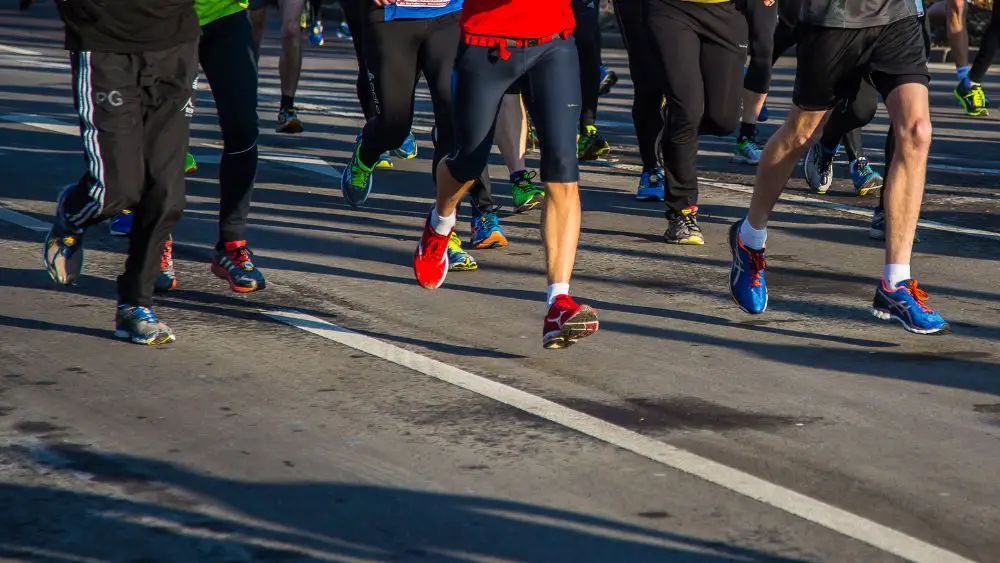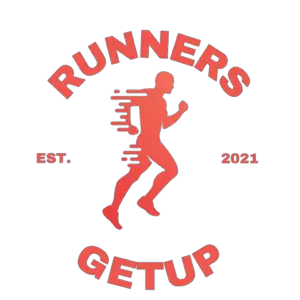This post contains affiliate links.

Soldiers wield weapons in battle. In the same way, we marathoners make use of running shoes to get through the harsh pavement. Furthermore, we are quick to think about buying a new one when we feel that our shoes are not performing like they used to. But is it okay to use new running shoes when running a marathon?
In general, you should not wear new running shoes on race day. Doing so may risk blisters and discomfort along the run. It is best to buy your running shoes 3-4 weeks before race day so you can test them out and get accustomed to them.
Ahead, we’ll talk about the benefits of using running shoes, when to buy a new one, and why you shouldn’t use new running shoes for the first time on race day.
Benefits of Using Proper Running Shoes
Before elaborating further on the topic, we must know the benefits of getting running shoes.
Many sports such as fencing and taekwondo have many gears associated with the game. They have full-on body protection to help players be safe. This is different from marathoning and running which only has one protective equipment: shoes.
Dr. Michael Scarcella, a Sports and Fitness Doctor, stated that running shoes are the sole protector that marathoners have in their bodies. Once it fails, we become prone to the dangers that the track may bring.
Running shoes have specialized heels to smoothen movement impacts. It also has a natural form designed for the human feet to aid in running. Do they make a difference? The answer is a big YES. With proper shoes, you’ll be up and performing to your greatest potential.
Ever tried running with sneakers? It hurts so much, right? This is because they are designed for fashion and not for strenuous activities. Experience has taught me that the ability to choose good shoes is a must-have skill for an expert marathoner.
Why You Shouldn’t Wear New Running Shoes on Race Day
Well technically you can, provided that you’ve tested your running shoes and have run in them a couple of times before the marathon.
But, it’s never a good idea to run with brand new running shoes for the first time in the race itself.
A marathon is 26 miles long. It’s a harsh experience, even for an experienced runner. Wearing a running shoe you haven’t tested yet might result in discomfort, change of biomechanics, and blisters which will ultimately affect your performance.
Breaking in New Pair of Shoes
Breaking in the shoe means letting your feet get accustomed to the feel of the shoe. Contrary to what most people believe, a great running shoe shouldn’t have a break-in period. Instead, they shoe feel comfortable running in right off the bat.
But it might take time for you to get accustomed to the feel of the shoe. Shoes have different shapes, cushion, feel, and shape which could affect your biomechanics and comfort. Hence, you need to spend a little bit of time running with your new shoes in training.
Before proceeding to a marathon event, make sure to get some miles in your new shoes. After all, your shoes should not be brand new on the day of the event.
30 miles (48km) to 40 miles (64km) is more than enough to get the hang of it. As such, you must always purchase new shoes not less than 3 weeks before the event to have enough time to test them out and make changes if needed.
Personally, I like to test new shoes in different intensities. I often do a few tempo runs and a few long runs just to see how they feel. I also use different socks every time to try and find the perfect match.
When Should I Replace My Running Shoes?
It is a rule of thumb to buy marathon shoes when you feel that they are already worn down or when you feel any sort of discomfort. On average, running shoes may last for 300 miles to 500 miles running depending on a variety of factors.
This is roughly the maximum mileage for optimal cushioning of impact, however, your shoes may need to be changed sooner or later depending on their condition.
Take note that those heavier individuals may need more frequent replacement of shoes. This is due to the additional pressure that is applied to the footwear compared to a lighter person.
Additionally, lightweight shoes typically used for fast running wear out faster. This is because they often use thinner, less durable materials to keep the shoe light and responsive.
Also read: 7 Signs You Need a New Pair of Running Shoes
Buying New Vs. Old Model
Buying new shoes that are the same model compared to your previous one has its fair share of benefits. For starters, shoes of the same model likely have the same features. Therefore, it may only take a few miles for you to get used to it.
For example, the Brooks Ghost 13, my favorite training shoe, feels pretty similar to the Brooks Ghost 14. So when I got the later version, I had no problems whatsoever running with it for a half marathon.
However, this does not mean that you can use them on the day of the run. You still need some mileage to test it out for any discomfort. It’s not uncommon for shoes of the same model to feel very different from their predecessor.
In contrast, having a completely new model of shoes need more time and mileage to get used to. Sometimes, it does feel better than your old ones but other times it may feel odd which is why you need that time to adjust.
Expert Tips for Choosing a Marathon Running Shoe
Here are some tips on choosing your new running shoes.
Prioritize Comfort over Fashion
Yes, that color might look good on you, but will your feet feel good too? This is one of the main questions you should ask before purchasing those new pairs.
Marathon is all about comfort and having no pain during the run. Looks come last as they won’t help you win the race or achieve personal goals.
We are quick to ask our friends what shoes are they using. However, choosing new shoes is a personal journey, as you are the only one who truly knows your fit, preference, and style.
Always prioritize convenience over trends and fads in the running world, as it will lead to better performance and fewer injuries.
Space is the Key
The wrong shoe size will result in discomfort and soreness. Worse, you might even get icky blisters because of it. Such occurrences will surely affect your training and your competition. Shoes that are too tight or too loose are simply a recipe for disaster.
A good rule to follow is to have space half or as large as your thumb’s width between your longest toe and the upper end of the shoe.
This allows your feet space to breathe as well as ample room for adjustment. Another tip is to simply add 0.5 to your size. Thus, a person with feet of size 9 must purchase a running shoe of size 9.5.
Recommended read: How Running Shoes Should Fit
Always Try it On
One rookie mistake that runners do is purchasing shoes online. While this might you save time from having to go to the store, it brings more disadvantages since you don’t get to try the shoes on before buying. The benefit of seeing and feeling the shoe firsthand is that you get to get a glimpse of its comfort in your feet.
Remember to never hesitate to try out different shoe styles in the stores. Brands have their sizing convention, and this is especially important for people with wider feet or higher arches.
Keeping it Fresh
How can you maintain your shoes for months? Here are some key tips:
Swap between pairs. Rotating between a set of shoes during training proves to be beneficial when you want to keep your kicks fresh. After all, the strain that should be on one pair is divided equally. This also allows the cushioning to last longer, as the soles are given ample time for decompression.
Moisture is the enemy. Once water seeps into the nooks and crooks of your running shoes, you can expect deterioration over time. This is why it is very important to dry your shoes, especially after exposure to water. Simply remove the insoles, set them in a dry place, and put some tissues/towels against them.
Strictly for running. Shoes dedicated solely for running last longer than those that are also worn for leisure. Even if it’s just for a quick stroll or a night out, it is best to not wear your running shoes casually as it might prematurely damage the materials.
Also read: How to prevent shoes from smelling
Final Thoughts
It might be tempting to wear new shoes on the day of the marathon. However, Every marathoner must put on a good amount of miles in their running shoes, especially if it’s a new one. Part of a good training regimen is choosing and maintaining gear for you to reach peak performance on race day.
As always, prioritize safety, comfort, and convenience even in picking running shoes. This leads to a fun, enjoyable, and fulfilling day on the track.
